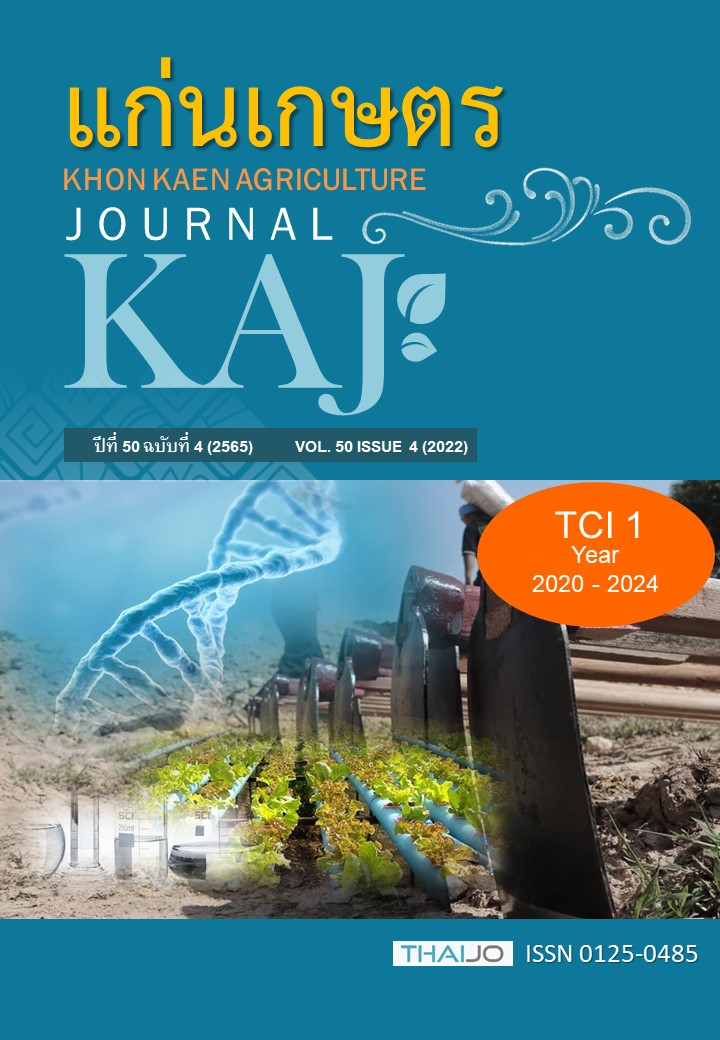ผลของอุณหภูมิต่ำต่อการเก็บรักษาดักแด้แมลงวันบ้านเพื่อการเลี้ยงเพิ่มปริมาณ และการเบียนของแตนเบียนดักแด้แมลงวันบ้าน (Spalangia gemina Boucek)
Main Article Content
บทคัดย่อ
การศึกษาการเก็บดักแด้เพื่อชะลอการเจริญเติบโตของแมลงวันบ้านจำเป็นต่อการเลี้ยงเพิ่มปริมาณในห้องปฏิบัติการและการเลี้ยงเพิ่มปริมาณแตนเบียนดักแด้แมลงวันบ้าน การศึกษาในครั้งนี้ทดสอบการชะลอฟักของดักแด้แมลงวันบ้านเพื่อการเลี้ยงเพิ่มปริมาณ ด้วยอุณหภูมิต่ำ ได้แก่ 8, 12 และ 16°C โดยเปรียบเทียบข้อมูลทางชีววิทยากับแมลงวันบ้านที่เลี้ยงในอุณหภูมิ 25°C โดยทดสอบกับดักแด้อายุ 2 และ 4 วัน เป็นเวลา 1-4 สัปดาห์ ผลการศึกษาพบว่า เมื่อระยะเวลาการเก็บดักแด้นานขึ้น อัตราการฟักเป็นตัวเต็มวัย และอายุของตัวเต็มวัยลดลง การเก็บรักษาดักแด้แมลงวันบ้านเป็นเวลา 1 สัปดาห์ มีอัตราการรอดชีวิตสูงกว่าระยะเวลาการเก็บอื่นๆ และดักแด้อายุ 4 วัน สามารถชะลอการฟักได้ทั้ง 3 อุณหภูมิ และมีการรอดชีวิตสูงกว่าดักแด้อายุ 2 วัน โดยอุณหภูมิ 12°C มีการรอดชีวิตใกล้เคียงกับตัวเต็มวัยมากที่สุด ส่วนการชะลอการเจริญเติบโตของดักแด้อายุ 1 วัน เพื่อใช้ในการเบียนของแตนเบียนดักแด้แมลงวันบ้าน โดยการเปรียบเทียบ ระหว่างอุณหภูมิ 0 และ 12°C พบว่า ดักแด้ที่เก็บรักษาในอุณหภูมิ 12°C มีอัตราการเบียนของแตนเบียนดักแด้แมลงวันบ้านสูงกว่าการเก็บที่อุณหภูมิ 0°C โดยการเก็บรักษาดักแด้ที่อุณหภูมิ 12°C เป็นเวลา 1 สัปดาห์ มีอัตราการเบียนสูงและสัดส่วนเพศผู้ต่อเพศเมียของแตนเบียนในรุ่นลูกใกล้เคียงกับดักแด้ที่เลี้ยงในอุณหภูมิ 25°C ที่ไม่มีการชะลอฟัก โดยอัตราการเบียนลดลงเมื่อระยะเวลาการเก็บรักษาดักแด้นานขึ้น ดังนั้นการใช้อุณหภูมิต่ำในระดับ 12°C ระยะเวลา 1 สัปดาห์ ในการเก็บรักษาดักแด้แมลงวันบ้านจึงเป็นทางเลือกที่ช่วยชะลอพัฒนาการของแมลงวันบ้านเพื่อการจัดการเลี้ยงเพิ่มปริมาณแมลงวันบ้าน และการผลิตแตนเบียน
Article Details

อนุญาตภายใต้เงื่อนไข Creative Commons Attribution-NonCommercial-NoDerivatives 4.0 International License.
เอกสารอ้างอิง
จักรวาล ชมภูศรี. 2553. ชีววิทยาและการควบคุมแมลงที่เป็นปัญหาสาธารณสุข.บริษัท หนังสือดีวัน จำกัด, กรุงเทพมหานคร.
สถาบันวิจัยวิทยาศาสตร์สาธารณสุข. 2553. ชีววิทยาและการควบคุมแมลงที่เป็นปัญหาสาธารณสุข.บริษัทหนังสือดีวันจำกัด, กรุงเทพมหานคร.
สิริภา แก้วคำแสน. 2556. การศึกษาชีววิทยาและประสิทธิภาพของแตนเบียน Spalangia gimina (Boucek) และ Pachycrepoideus vindermiae (Rondani) (Hymenoptara: Pteromalidae) ต่อดักแด้แมลงวันบ้าน (Musca domestica Linnaeus). วิทยานิพนธ์ปริญญาวิทยาศาสตร์มหาบัณฑิต มหาวิทยาลัยขอนแก่น, ขอนแก่น.
อุบล ตังควานิช. 2555. แตนเบียนดักแด้แมลงวันบ้าน ประสิทธิภาพและการนำไปใช้ควบคุมโดยชีววิธีในฟาร์มปศุสัตว์. แก่นเกษตร. 40: 379-386.
Analytical software. 2013. Statistix10 analytical software for researchers. Analytical software. Tallahassee, FL.
Apiwathnasorn, C. 2012. Literature review of Parasitoid of filth flies in Thailand: A list of species with brief notes on bionomic of common species. Southeast Asian Journal of Tropical Medicine and Public Health. 43(1): 48-54.
Barnard, D. R., and C.J. Geden. 1993.Influence of larval density and temperature in poultry manure on development of the house fly (Diptera: Muscidae). Environmental Entomology. 22: 971-977.
Chen, S., S. J. Fleischer, M. C. Saunders, and M. B. Thomas. 2015. The influence of diurnal temperature variation on degree-day accumulation and Insect life history. Plos One. 10(3): e0120772.
Chiel, E., and W. Kuslitzky. 2016. Diversity and abundance of house fly pupal parasitoids in Israel, with first records of two Spalangia species. Environmental Entomology. 45(2): 283-91.
Floate, K. D. 2002. Production of filth fly parasitoids (Hymenoptera: Pteromalidae) on fresh and on freeze-killed and stored house fly pupae. Biocontrol Science and Technology. 12(5): 595–603.
Geden, C. J., and P. E. Kaufman. 2007. Development of Spalangia cameroni and Muscidifurax raptor (Hymenoptera: Pteromalidae) on live house fly (Diptera: Muscidae) pupae and pupae killed by heat shock, irradiation, and cold. Environmental Entomology. 36(1): 34–39.
Hallman, G. J., and D. L. Denlinger. 2019. Temperature sensitivity in insects and application in integrated pest management. CRC Press. New York.
Kaufman, P. E., and C. J. Geden. 2009. Development of Spalangia cameroni and Muscidifurax raptor (Hymenoptera: Pteromalidae) on live and freeze-killed house fly (Diptera: Muscidae) pupae. Florida Entomologist. 92(3): 492–496.
Legner, E. F., and D. Gerling. 1967. Host-feeding and oviposition on Musca domestica by Spalangia cameroni, Nasonia vitripennis, and Muscidifurax raptor (Hymenoptera: Pteromalidae) influences their longevity and fecundity. Entomological Society of America. 60(3): 678-91.
Leopold, R. A., R. R. Rojas, and P. W. Atkinson. 1998.Post pupariation cold storage of 3 species of flies: increasing chilling tolerance by acclimation and recurrent recovery periods. Cryobiology. 36: 213-224.
Mellanby, K. 1939. Low temperature and insect activity. The Royal Society Publishing. 127(849): 473-487.
Morgan, P. B. 1981. The potential use of parasites to control Musca domestica L. and other filth breeding flies at agricultural installations in the southern United States. Science and Education Administration. 11: 25.
Nevan L. G. 2000. Physiological responses of insects to heat. Postharvest Biology and Technology. 21: 103–111.
Ogawa, K., K. Ito, T. Fukuda, S. I. Tebayashi, and R. Arakawa. 2012. Host suitability of house fly, Musca domestica (Diptera: Muscidae), pupae killed by high or low temperature treatment for a parasitoid, Spalangia endius (Hymenoptera: Pteromalidae). Scientific World Journal. 1: 214907.
Roth, J. P., G. T. Fincher, and J. W. Summerlin. 1991. Suitability of irradiated or freeze-killed horn by (Diptera: Muscidae) pupae as hosts for hymenopterous parasitoids. Economic Entomology. 84: 94-98.
Rueda, L. M., and R. C. Axtell. 1987. Reproduction of Pteromalidae (Hymenoptera) parasitic on fresh and frozen house fly (Musca domestica Linn.) pupae. Philippine Journal of Science. 116: 313-326.
Shahzad, A. N., B. Aslam, G. L. Abdul, W. S. Abdul, H. N. Riaz, and A. C. Waqar. 2016. Effect of lowest temperatures on storage of pupal parasitoid, Dirhinus giffardii. Science international. 28(5): 4756-4762.
Sanchez-Arroyo, H., and J. L. Capinera. 2017.common name: house fly. Available: https://entnemdept.ufl.edu/creatures/urban/flies/house_fly.htm. Accessed Jul. 10, 2021.
Stejskal, V., O. T. Vendl, Z. Li, and R. Aulicky. 2019. Minimal thermal requirements for development and activity of stored product and food industry pests (Acari, Coleoptera, Lepidoptera, Psocoptera, Diptera and Blattodea): A Review. Insect. 10(5): 149.
Ssepuuya, G., D. Nakimbugwe, A. D. Winne, R. Smets, J. Claes, and M. V. D. Borght. 2020. Effect of heat processing on the nutrient composition, colour, and volatile odour compounds of the long-horned grasshopper Ruspolia differens servile. National Library of Medicine. 129: 108831.
Skovgard, H., and G. Nachman. 2004.Biological control of house flies Musca domestica and stable flies Stomoxys calcitrans (Diptera: Muscidae) by means of inundative releases of Spalangia cameroni (Hymenoptera: Pteromalidae). Environmental Entomology. 94(6): 555-67.
Wang, Y., L. Yang, Y. Zhang, L. Tao, and J. Wang. 2018. Development of Musca domestica at constant temperatures and the first case report of its application for estimating the minimum postmortem interval. Forensic Science International. 285: 172-18.


